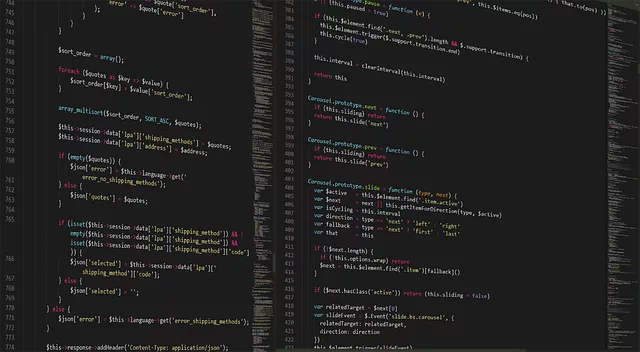Full-stack development is a comprehensive approach where developers master both front-end (user interfaces using HTML, CSS, JavaScript) and back-end (databases, servers, APIs) website creation. This holistic knowledge enables them to manage the entire lifecycle of web applications. Website Development involves separating creative and technical aspects into front-end and back-end components. The right technology stack, based on project scope and team expertise, is crucial for efficient workflow and successful outcomes. Visually appealing interfaces are created through collaboration between designers and developers using tools like Figma or Sketch. Full-stack developers ensure data security through server-side logic and database management practices. APIs enable seamless integration of functionalities, expanding a site's capabilities. Deployment and hosting turn digital projects into global resources, with choices between cloud-based services and traditional servers. Full-stack developers play a vital role in maintaining and updating websites to meet evolving user expectations, ensuring continuous improvement and long-term success.
Dive into the dynamic world of full-stack website development, where mastering both front-end and back-end technologies is the key to crafting robust online experiences. This comprehensive guide explores every layer of web creation. From understanding the core components that define front-end vs. back-end to choosing the right tech stack for your project, we’ll uncover design strategies, server-side logic, API integration, deployment, and maintenance best practices. Elevate your website development skills with these essential insights.
Understanding Full-Stack Development: A Comprehensive Overview

Full-stack development refers to the creation and management of both front-end (user-facing) and back-end (server and application logic) portions of a website or web application. It’s a comprehensive approach where developers are proficient in all layers of web development, from building user interfaces with HTML, CSS, and JavaScript on the front end, to working with databases, servers, and APIs on the back end.
This holistic understanding allows full-stack developers to navigate the entire website development lifecycle. They can design elegant user experiences, ensure seamless interactions, and efficiently manage data storage and retrieval. By wearing multiple hats, they contribute significantly to project success, streamlining workflows, and fostering collaboration within development teams.
Front-End vs Back-End: The Core Components of a Website

The development world of websites is split into two primary components: front-end and back-end, each with its own set of responsibilities. Front-end development is the creative part that deals with what users directly interact with. It involves designing and coding the visual elements like layouts, buttons, forms, and graphics that make a website aesthetically pleasing and user-friendly. The primary goal is to ensure an intuitive and engaging user experience, translating design concepts into interactive digital interfaces.
On the other hand, back-end development is the technical backbone of any website. It encompasses server-side operations, data storage, and business logic. Back-end developers build and maintain the systems that power the front-end, including databases, servers, APIs (Application Programming Interfaces), and security protocols. These elements facilitate data management, communication between different parts of the application, and ensure the overall functionality and performance of the website, enabling it to handle user requests efficiently. Together, front-end and back-end components form a cohesive unit that brings any online platform to life, enhancing its functionality and user experience in Website Development.
Choosing the Right Technologies for Your Full-Stack Project

When embarking on a full-stack website development project, one of the most critical decisions is selecting the appropriate technologies. This choice will significantly impact the efficiency of your workflow and the overall success of the project. It’s essential to consider factors like project scope, scalability, and your team’s expertise. For instance, choosing a robust backend framework like Node.js or Django can provide powerful server-side functionality, while modern frontend libraries such as React or Angular can enhance user interaction and application performance.
The technology stack should also cater to the specific requirements of your website development project. For dynamic websites with complex interactions, a combination of these tools might be ideal. However, for simpler static sites, lighter alternatives like HTML, CSS, and JavaScript could suffice. Staying updated with industry trends and best practices is crucial, as new technologies emerge, offering improved efficiency and security for Website Development.
Building a Robust User Interface: Design and Development Strategies

Creating a visually appealing and user-friendly interface is paramount in modern website development. Designers and developers collaborate to transform wireframes into interactive experiences, ensuring every element aligns with user expectations. Tools like Figma or Sketch facilitate design processes, allowing for real-time collaboration and easy iteration. These platforms enable the creation of responsive layouts, catering to various devices and screen sizes.
Development strategies often involve a combination of HTML, CSS, and JavaScript. Frameworks such as React or Angular streamline the process by providing pre-built components and simplifying dynamic content rendering. By implementing these design and development practices, developers build robust user interfaces that not only enhance the visual appeal but also contribute to improved website performance and user engagement, ultimately driving better conversion rates.
Server-Side Logic and Database Management: Ensuring Data Security

In full-stack website development, Server-Side Logic and Database Management are critical components that ensure data security. The server-side logic involves handling user requests, processing data, and generating dynamic content, all while adhering to stringent security protocols. This includes implementing measures like input validation, encryption for sensitive data, and access control mechanisms to prevent unauthorized access.
Database management plays a pivotal role in securing user information by employing robust database design principles and access controls. Developers must choose appropriate database systems, implement secure connections, and regularly update security patches to safeguard data from potential threats. By integrating these practices, developers can ensure that the Website Development process maintains the integrity and confidentiality of user data, fostering trust among users and enhancing the overall security posture of the application.
Integrating APIs: Expanding Functionality and Connectivity

In the realm of website development, APIs (Application Programming Interfaces) serve as powerful tools for integrating diverse functionalities and establishing seamless connectivity between different systems. By leveraging APIs, developers can enhance a website’s capabilities beyond its core features. For instance, an e-commerce platform might utilize APIs to integrate secure payment gateways, enabling users to make transactions seamlessly without leaving the site. Additionally, weather APIs can be employed to display real-time forecasts on travel or lifestyle websites, providing valuable information to visitors.
Full-stack development involves understanding and managing both front-end and back-end aspects, including the strategic placement of APIs. Integrating these interfaces allows developers to tap into external data sources, third-party services, and web APIs, thereby expanding the website’s reach and functionality. This capability is particularly beneficial for dynamic websites that require up-to-date content or those aiming to offer personalized user experiences through data aggregation from multiple sources.
Deployment and Hosting: Making Your Website Live and Accessible

Deployment and hosting are crucial steps in the website development process, transforming your online project into a live, accessible resource for users worldwide. Once your website is built, you need to choose a suitable platform to host it, ensuring it can handle traffic and providing a secure environment. This involves selecting between cloud-based hosting services or traditional servers, each with its own advantages. Cloud hosting offers scalability and cost-effectiveness, allowing you to easily adjust resources based on demand, while dedicated servers provide enhanced control and security for mission-critical applications.
The deployment process involves uploading your website files to the chosen host, configuring database connections, and setting up any necessary software or dependencies. Automating this process through continuous integration and deployment (CI/CD) pipelines streamlines updates and ensures a seamless user experience. Effective hosting strategies not only make your website live but also guarantee its performance, reliability, and security, ultimately contributing to the success of your online venture in the competitive world of website development.
Continuous Improvement and Maintenance: Evolving with Web Technologies

In the dynamic landscape of website development, continuous improvement and maintenance are non-negotiable for staying ahead in the ever-evolving digital realm. Full-stack developers play a pivotal role here, as they not only build but also maintain and update websites to keep them functional, secure, and engaging. With web technologies rapidly advancing, it’s crucial for developers to stay abreast of emerging trends like responsive design, mobile optimization, and cutting-edge frameworks to deliver top-notch user experiences. Regular updates are essential to address performance bottlenecks, patch security vulnerabilities, and integrate new features that enhance website functionality.
This ongoing process involves regularly reviewing codebases, implementing best practices, and staying connected with the developer community for knowledge sharing. By embracing continuous improvement, full-stack developers ensure their websites remain competitive, user-friendly, and aligned with evolving user expectations in an ever-changing digital world. This proactive approach not only keeps websites relevant but also contributes to their long-term success and sustainability.
